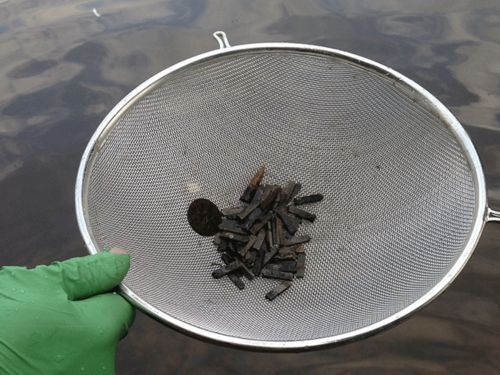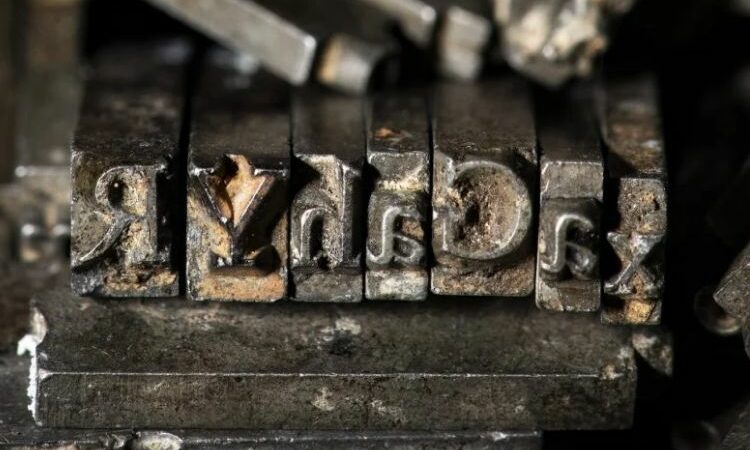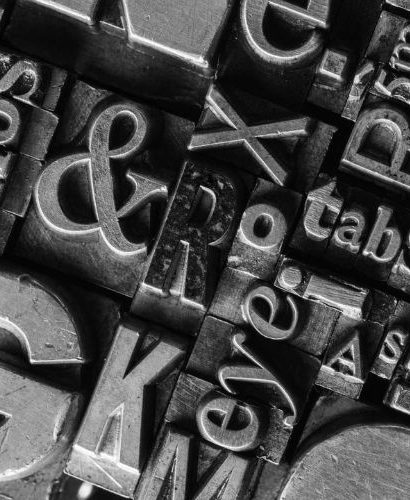The Doves Typeface legend is one of the most enduring in typographic history and probably the most infamous. It’s the story of a typeface and a bitter feud between the two partners of Hammersmith’s celebrated Doves Press, Thomas James Cobden-Sanderson and Emery Walker leading to a protracted disposal of their metal type into London’s River Thames.
Piecing together the history
The Doves Press was founded in 1900 in Hammersmith, London, by Thomas James Cobden-Sanderson, with Emery Walker joining him the same year as his partner.
The venture proved hugely successful; their five volume “English Bible” made the press a large profit. These “Doves Bibles” are still immensely valuable and can fetch over $45,000 when sold today.

The Doves Bible
During almost seventeen years of operation the Press produced some of the finest examples of twentieth century typography, the distinguishing and most celebrated feature of its books being a specially devised fount of type.
With its extra-wide capital letters, diamond shaped punctuation and unique off-kilter dots on the letter “i,” Doves Type became the press’s hallmark. The typeface was produced in one size only, ‘two-line Brevier’ (equivalent to 16 pt).

The Doves Text font compared to original printed sources by the Doves Press
Over time, however, the two men’s personal and professional relationship broke down. By 1909, they fell into a bitter dispute resulting in their partnership’s dissolution. Cobden Sanderson continued to run Doves Press until 1916, but never came to terms with the fact that their parting agreement decreed that ownership of the typeface would go to Walker on Cobden Sanderson’s death.
The plot thickens
When the Press closed in 1917, an epitaph appeared in its final publication announcing that Cobden-Sanderson had ‘bequeathed’ the Doves Press Fount of Type to the bed of the River Thames.
As it happened, around 1913, printer T.J. Cobden-Sanderson, after ruminating for years about whether he should do it, secretly started to throw away all the metal letterpress type he and his partner made into the river. He did this because he was angry at his partner and thought Walker was trying to cheat him.
Between late 1916 and January 1917, an elderly Cobden-Sanderson made about 170 secret trips during which, as he put it in his journals, slowly but surely thrown more than a ton (or 2,600 pounds) of the typeface, bundled into individual 12-pound paper parcels off the side of the nearby Hammersmith Bridge.
Before its consignment to the waters, he’d written: “It is my wish that the Doves Press type shall never be subjected to the use of a machine other than the human hand, in composition, or to a press pulled otherwise than by the hand and arm of man or woman.”
Cobden Sanderson said it himself: “If Emery Walker wants to find it, he’ll have to dive for it.”
And there it lay, resting on the riverbed, seemingly lost to the world.
Until…
Robert Green, a designer, became intrigued by the typeface, recreated it digitally and then decided to instigate a search in the mud under the bridge.
He first became fascinated with Doves Type in the mid-2000s, scouring printed editions and online facsimiles, to try and faithfully redraw and digitize every line.
In 2013, he released the first downloadable version on typespec, but remained dissatisfied.
When he first entertained the idea of venturing to the Thames in search of the legendary typeface, the prevailing response he encountered was a common dismissal of the likelihood of success. The common reason cited for this was the frequent dredging of the river and the fast tide (and not to mention Doves Typeface’s century-long submersion).
In October 2014, he decided to take to the river to see if he could find any of the original pieces.
With the aid of historical records and Cobden-Sanderson’s personal diaries, he identified the precise location on Hammersmith Bridge where Cobden-Sanderson had secretly disposed of the type.

The Doves Press type sifted from the Thames
Green said, “I’d only been down there 20 minutes and I found few pieces,”. “So, I got in touch with the Port of London Authority, and they came down to search in a meticulous spiral.” The team of scuba divers used the rather low-tech tools of a bucket and a sieve to sift through the riverbed.

Doves Type recovered by Robert Green, 2014
They managed to recover 151 sorts (the name for individual pieces of type) out of a possible 500,000. “It’s a tiny fraction, but when I was down by the river on my own, for one second it all felt very cosmic,” he said. “It was like Cobden-Sanderson had dropped the type from the bridge and straight into my hands. Time just collapsed.”
Restoring the type
It is truly remarkable to consider that a designer born over a century after Cobden Sanderson took on the task of digitally restoring his life’s work, which was left in ruins.

Digital restoration of Doves typeface by Robert Green
Today, anyone can download and buy Green’s revival of Cobden Sanderson’s type online.
As for metal punches he retrieved from the Thames, Green decided to keep half for himself and generously donate the other half to the Emery Walker Trust. This trust is responsible for maintaining Walker’s former home as a museum dedicated to his remarkable contributions.
Interestingly, a hundred years ago, Cobden Sanderson had famously proclaimed that Walker would have to dive for his share of the business. Strangely enough, Walker had received his half, thanks to Green acting as a devoted and benevolent proxy diver.
There were other takers too
Much like Green, there were others like Sandy who were captivated by the Doves Typefaces and went on to mount several exhibitions to showcase these salvaged pieces of type both by Green himself and mudlarks like Lucasz Orlinski and Angus McArthur.
For Sandy, the thrill comes from the discovery of both rare and everyday artifacts, which can lead to an entirely new line of inquiry: “The Thames is very democratic. It gives you a clear picture of what people have been wearing or using over thousands of years. And it’s not carefully curated by a museum. The river gives up these objects randomly, and you experience these amazing stories of ordinary Londoners. It creates a very tangible connection to the past. Every object leads you down a rabbit hole.”
100 years later, the concerns of a man obsessed with craft still resonate with us. Sanderson’s concerns about the relentless march of industrialization and the mechanization of his cherished bookbinding craft resonate even today. His unwavering dedication to handmade creations echoes in the struggles faced by modern graphic designers amidst the relentless wave of digitalization and the rapid advancement of technology.
As the digital era continues to evolve, fonts like Doves serve as poignant reminders of the craftsmanship, art, and cultural value woven into the fabric of typeface history.
At Machine Dalal, you will find a wide selection of printing, packaging and converting equipment including foil packaging machines from sellers worldwide. We as an online platform are committed to tapping new business opportunities for both sellers and buyers of printing equipment across the globe.
With our aim for high levels of customer satisfaction, we will do everything that we can to accommodate you and meet your expectations.
Contact us to know more and download the app for a richer, more personalized experience or contact us to know more.
Subscribe to our newsletter for the latest news and updates on recently listed Print, Packaging and Converting equipment.




